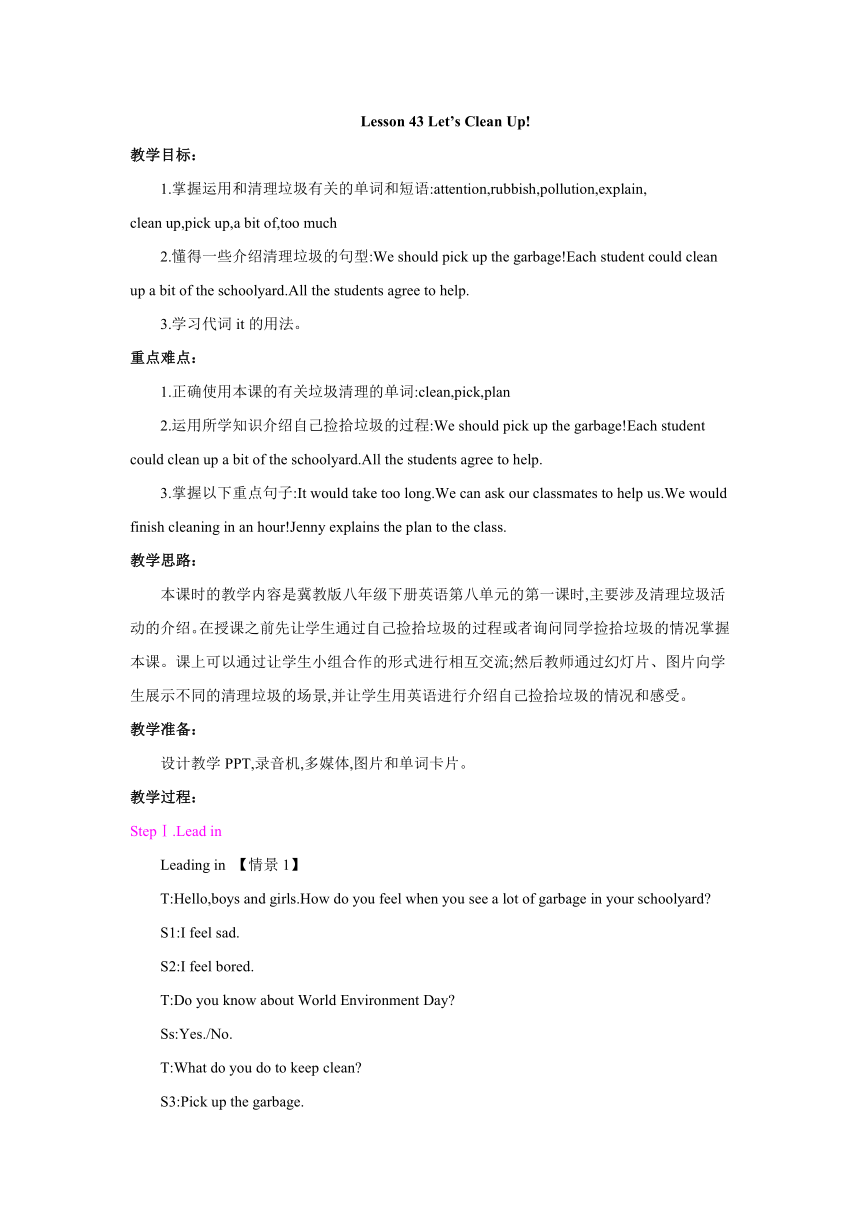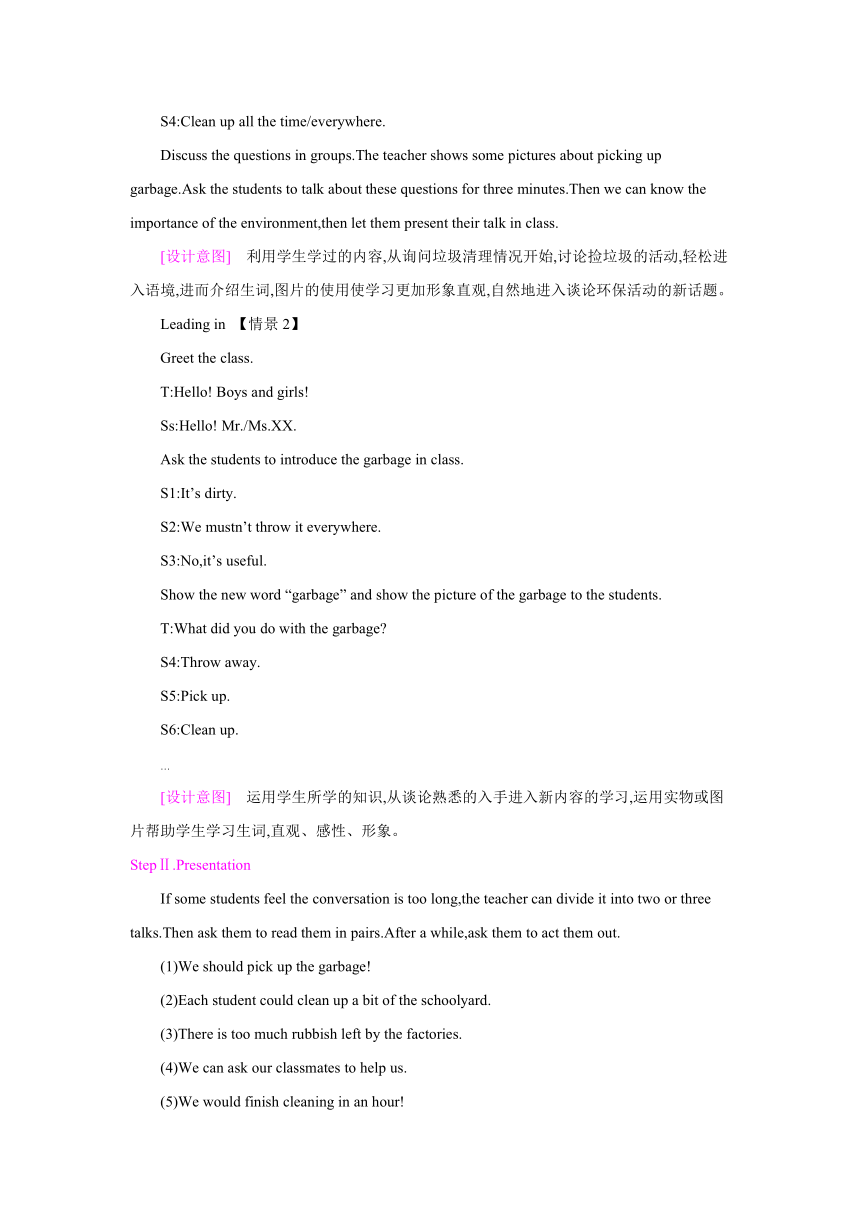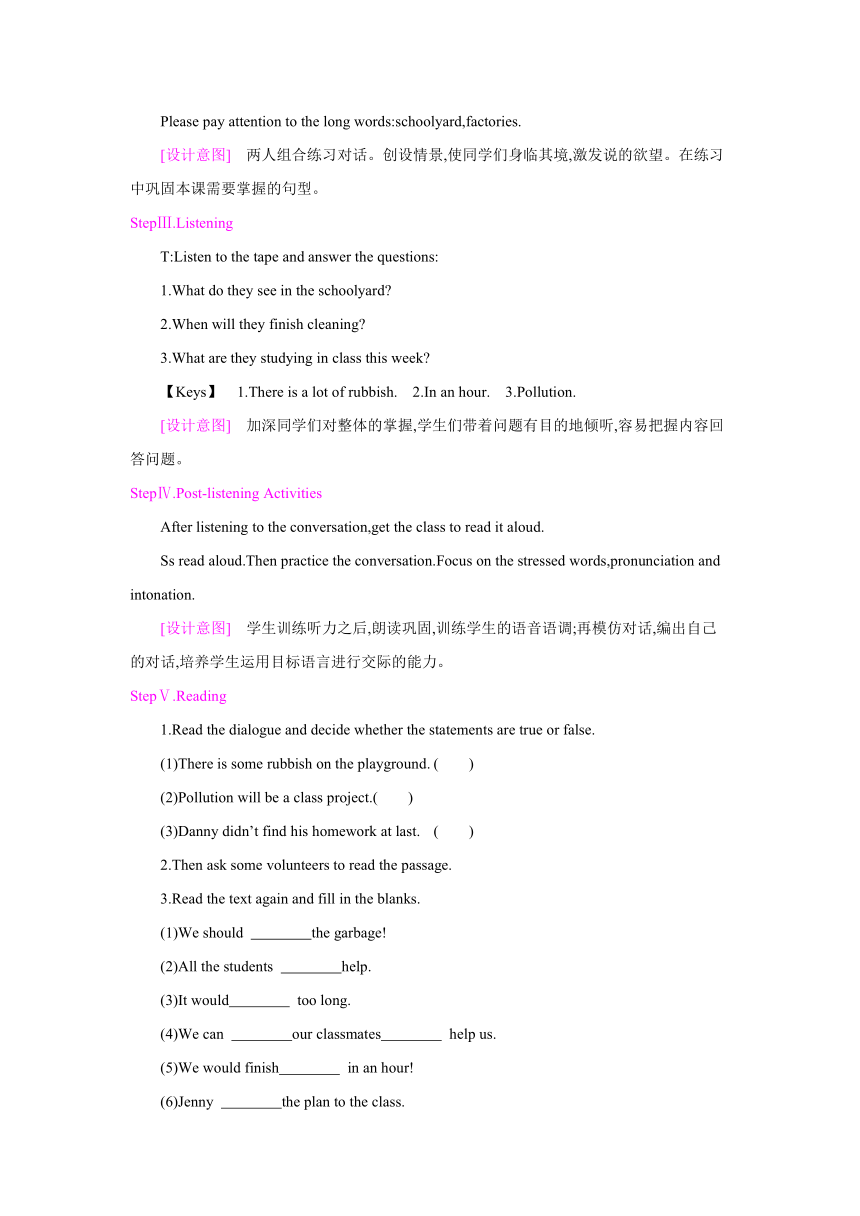Lesson 43 Let’s Clean Up! 教学设计
文档属性
| 名称 | Lesson 43 Let’s Clean Up! 教学设计 |  | |
| 格式 | zip | ||
| 文件大小 | 27.4KB | ||
| 资源类型 | 教案 | ||
| 版本资源 | 冀教版 | ||
| 科目 | 英语 | ||
| 更新时间 | 2019-06-29 07:14:33 | ||
图片预览




文档简介
Lesson 43 Let’s Clean Up!
教学目标:
1.掌握运用和清理垃圾有关的单词和短语:attention,rubbish,pollution,explain,
clean up,pick up,a bit of,too much
2.懂得一些介绍清理垃圾的句型:We should pick up the garbage!Each student could clean up a bit of the schoolyard.All the students agree to help.
3.学习代词it的用法。
重点难点:
1.正确使用本课的有关垃圾清理的单词:clean,pick,plan
2.运用所学知识介绍自己捡拾垃圾的过程:We should pick up the garbage!Each student could clean up a bit of the schoolyard.All the students agree to help.
3.掌握以下重点句子:It would take too long.We can ask our classmates to help us.We would finish cleaning in an hour!Jenny explains the plan to the class.
教学思路:
本课时的教学内容是冀教版八年级下册英语第八单元的第一课时,主要涉及清理垃圾活动的介绍。在授课之前先让学生通过自己捡拾垃圾的过程或者询问同学捡拾垃圾的情况掌握本课。课上可以通过让学生小组合作的形式进行相互交流;然后教师通过幻灯片、图片向学生展示不同的清理垃圾的场景,并让学生用英语进行介绍自己捡拾垃圾的情况和感受。
教学准备:
设计教学PPT,录音机,多媒体,图片和单词卡片。
教学过程:
StepⅠ.Lead in
Leading in 【情景1】
T:Hello,boys and girls.How do you feel when you see a lot of garbage in your schoolyard?
S1:I feel sad.
S2:I feel bored.
T:Do you know about World Environment Day?
Ss:Yes./No.
T:What do you do to keep clean?
S3:Pick up the garbage.
S4:Clean up all the time/everywhere.
Discuss the questions in groups.The teacher shows some pictures about picking up garbage.Ask the students to talk about these questions for three minutes.Then we can know the importance of the environment,then let them present their talk in class.
[设计意图] 利用学生学过的内容,从询问垃圾清理情况开始,讨论捡垃圾的活动,轻松进入语境,进而介绍生词,图片的使用使学习更加形象直观,自然地进入谈论环保活动的新话题。
Leading in 【情景2】
Greet the class.
T:Hello! Boys and girls!
Ss:Hello! Mr./Ms.XX.
Ask the students to introduce the garbage in class.
S1:It’s dirty.
S2:We mustn’t throw it everywhere.
S3:No,it’s useful.
Show the new word “garbage” and show the picture of the garbage to the students.
T:What did you do with the garbage?
S4:Throw away.
S5:Pick up.
S6:Clean up.
…
[设计意图] 运用学生所学的知识,从谈论熟悉的入手进入新内容的学习,运用实物或图片帮助学生学习生词,直观、感性、形象。
StepⅡ.Presentation
If some students feel the conversation is too long,the teacher can divide it into two or three talks.Then ask them to read them in pairs.After a while,ask them to act them out.
(1)We should pick up the garbage!
(2)Each student could clean up a bit of the schoolyard.
(3)There is too much rubbish left by the factories.
(4)We can ask our classmates to help us.
(5)We would finish cleaning in an hour!
Please pay attention to the long words:schoolyard,factories.
[设计意图] 两人组合练习对话。创设情景,使同学们身临其境,激发说的欲望。在练习中巩固本课需要掌握的句型。
StepⅢ.Listening
T:Listen to the tape and answer the questions:
1.What do they see in the schoolyard?
2.When will they finish cleaning?
3.What are they studying in class this week?
【Keys】 1.There is a lot of rubbish. 2.In an hour. 3.Pollution.
[设计意图] 加深同学们对整体的掌握,学生们带着问题有目的地倾听,容易把握内容回答问题。
StepⅣ.Post-listening Activities
After listening to the conversation,get the class to read it aloud.
Ss read aloud.Then practice the conversation.Focus on the stressed words,pronunciation and intonation.
[设计意图] 学生训练听力之后,朗读巩固,训练学生的语音语调;再模仿对话,编出自己的对话,培养学生运用目标语言进行交际的能力。
StepⅤ.Reading
1.Read the dialogue and decide whether the statements are true or false.
(1)There is some rubbish on the playground. ( )
(2)Pollution will be a class project. ( )
(3)Danny didn’t find his homework at last. ( )
2.Then ask some volunteers to read the passage.
3.Read the text again and fill in the blanks.
(1)We should the garbage!?
(2)All the students help.?
(3)It would too long.?
(4)We can our classmates help us.?
(5)We would finish in an hour!?
(6)Jenny the plan to the class.?
【Keys】 1.(1)F (2)T (3)F 3.(1)pick up (2)agree to (3)take (4)ask,to (5)cleaning (6)explains
☆教材解读☆
1.We should pick up the garbage!?
句中pick up意思是“捡起”,是“动词+ 副词”短语,后面接名词或者代词,当代词作宾语时,必须放在两词中间。
You should pick up those books.
你应该捡起那些书。
Look at those books.You should pick them up.看看那些书。你应该捡起它们。
【拓展】 pick up也可以表示“情况改善,接人,载人,懂得”等。
(1)表示“情况改善”。
The economy of the shop has picked up.
商店的经济有好转了。
(2)表示“接人”。
She can pick you up.她能接你。
(3)表示“载人”。
There is a bus to pick up foreigners.
有一辆公交车去接外国人。
(4)表示“懂得”。
He picked up some French last year.
他去年学了一些法语。
2.Each student could clean up a bit of the schoolyard.?
◆句中clean up是动副短语,意思是“打扫”,后面可以接名词或者代词作宾语,接名词作宾语的时候,放在中间、后面都可以,接代词作宾语,放在两个词的中间。
The students are cleaning the park up.
学生们正在打扫公园。
The classroom is dirty.Lily will clean it up.教室很脏。莉莉将去打扫一下。
【拓展】 含有up 的词组:
(1)come up with想出。
He couldn’t come up with an answer.
他答不上来。
(2)ring up打电话。
Last evening I was rung up by an old friend.昨晚一位老朋友打电话给我了。
(3)put up举起。
He put up his hand in a salute.他举手致敬。
(4)make up构成。
He made up some excuses about being sick.他编造了一些借口,说他病倒了。
(5)look up查询。
We can look up the word in the dictionary.
我们可以在字典里查这个词。
(6)fix up修理。
We shall have to fix the house up before we can sell it.我们得把房子修缮了后才能出售。
(7)catch up with赶上。
He stopped and let her catch up with him.
他停下来,好让她追上自己。
(8)dress up打扮。
Don’t bother to dress up—come as you are.用不着穿讲究衣服——就穿平常的衣服来吧。
◆句中bit 作名词,意思是“一点儿”,一般用于短语a bit of 和a bit中。a bit of后面接不可数名词,表示“一点儿”之意,和a little 意思一样。a bit 一般充当副词,表示“稍微”之意。a bit 后面可以修饰形容词和副词的原级,还有比较级。
With a bit of water,he climbed the mountains last week.上周带着一点水,他爬上了山。
The weather is a bit hot here.
这儿天有点儿热。
This desk is a bit longer than that one.
这张桌子比那张长一点儿。
【辨析】 a bit,a little
(1)a bit和 a little 在修饰形容词或者副词时,两短语可以互换。
He is a bit/a little stronger than his brother.他比他弟弟强壮一点儿。
(2)a bit修饰名词时,需要加上of,构成“ a bit of + 名词”,而a little修饰名词时,直接接名词。a bit 和 a little都只能修饰不可数名词。
She has a bit of/a little water in her bottle.她瓶子里只有一点儿水了。
3.There is too much rubbish left by the factories.?
◆句中too much意思是“太多”,可以作形容词,修饰不可数名词,也可以作副词,修饰不及物动词。
He spent too much money on books.
他花了太多钱在书上。
They drank too much.他们喝太多了。
【辨析】 too much,much too,too many
(1)too much意思是“太多”,可以修饰不可数名词,也可以修饰不及物动词。
You eat too much.你吃太多了。
(2)much too意思是“太”,可以修饰形容词或者副词。
The water is much too cold.水太冷了。
(3)too many意思是“太多”,可以修饰可数名词的复数。
You have too many clothes.
你有太多衣服。
◆句中left by the factories是过去分词短语,作后置定语,修饰前面的名词rubbish,其中left 是leave 的过去分词形式,意思是“把……留在某处”。过去分词短语作后置定语时,相当于一个定语从句。在句中,及物动词的过去分词一般表示被动意义,而不及物动词的过去分词表示动作的完成,无被动意义。
There are many buildings left by ancient people.
=There are many buildings that were left by ancient people.有许多建筑物,是古人留下的。
[设计意图] 学生通过阅读课文,掌握重点内容,并且通过判断正误来巩固对课文的理解和掌握;朗读课文并做填空练习,掌握课文重点内容。
StepⅥ.Complete Let’s Do It!
Ask the students to read the lesson and answer the questions in No.1,then ask the students to listen to the lesson and finish No.2,and ask the students to read the lesson again and answer the questions in No.3.Pay attention to the new words and phrases.
[设计意图] Let’s Do It!中No.1重点是阅读教学,回忆了课文的内容,使学生又一次巩固了文中知识,培养了阅读的能力。No.2重点是听力教学,训练学生的听力能力,巩固了课文内容,No.3强调的是文中的重点单词的用法,加以训练。
StepⅦ.Task
GROUP WORK:Let’s Do It! No.4
Ask students to come to the front of the classroom,and some start walking towards others as the teacher says “go”.They must stop as the teacher says “stop”.Then they can make a new group with the student who is standing in front of him/her.
[设计意图] No.4的重点是掌握世界环境日,同学们通过随机组合来完成小组合作。以“环保”为话题,提供了一个语境完整、内容丰富的对话,自然呈现本单元的核心句型,为学生进一步输出语言提供了口语示范。
StepⅧ.Exercises
T:Now,look at the sentences with some missing words.Please use proper words to fill them.
1.They always (捡起)garbage in their schoolyard.?
2.She (打扫)her room every day.?
3.There is (太多) money in this bag.?
4.This coat is (有点)small for me.?
5. (有)a lot of rubbish in the park.?
【Keys】 1.pick up 2.cleans up 3.too much 4.a bit 5.There is
[设计意图] 以学评教、强化落实。当堂检测主要是由本节内容组成的形成性评价,利用已知的信息,让学生补充,让他们得到充分的训练。
StepⅨ.Homework
1.Practice the conversations with your group members after class.
2.Copy the new words twice.
[设计意图] 口头练习和单词记忆相结合,复习、归纳,注重语言知识的操练与积累。
Lesson 43 Let’s Clean Up!
attention,rubbish,pollution,explain
clean up,pick up,a bit of,too much
We should pick up the garbage!
Each student could clean up a bit of the schoolyard.
All the students agree to help.
It would take too long.
We can ask our classmates to help us.
We would finish cleaning in an hour!
Jenny explains the plan to the class.
教材习题解答
【Lesson 43】
1 1.T 2.F 3.F 4.T
2 1.In the schoolyard. 2.Picking up garbage. 3.Pollution.
3 rubbish;pollution;agree;attention;schoolyard;cleaning
教学目标:
1.掌握运用和清理垃圾有关的单词和短语:attention,rubbish,pollution,explain,
clean up,pick up,a bit of,too much
2.懂得一些介绍清理垃圾的句型:We should pick up the garbage!Each student could clean up a bit of the schoolyard.All the students agree to help.
3.学习代词it的用法。
重点难点:
1.正确使用本课的有关垃圾清理的单词:clean,pick,plan
2.运用所学知识介绍自己捡拾垃圾的过程:We should pick up the garbage!Each student could clean up a bit of the schoolyard.All the students agree to help.
3.掌握以下重点句子:It would take too long.We can ask our classmates to help us.We would finish cleaning in an hour!Jenny explains the plan to the class.
教学思路:
本课时的教学内容是冀教版八年级下册英语第八单元的第一课时,主要涉及清理垃圾活动的介绍。在授课之前先让学生通过自己捡拾垃圾的过程或者询问同学捡拾垃圾的情况掌握本课。课上可以通过让学生小组合作的形式进行相互交流;然后教师通过幻灯片、图片向学生展示不同的清理垃圾的场景,并让学生用英语进行介绍自己捡拾垃圾的情况和感受。
教学准备:
设计教学PPT,录音机,多媒体,图片和单词卡片。
教学过程:
StepⅠ.Lead in
Leading in 【情景1】
T:Hello,boys and girls.How do you feel when you see a lot of garbage in your schoolyard?
S1:I feel sad.
S2:I feel bored.
T:Do you know about World Environment Day?
Ss:Yes./No.
T:What do you do to keep clean?
S3:Pick up the garbage.
S4:Clean up all the time/everywhere.
Discuss the questions in groups.The teacher shows some pictures about picking up garbage.Ask the students to talk about these questions for three minutes.Then we can know the importance of the environment,then let them present their talk in class.
[设计意图] 利用学生学过的内容,从询问垃圾清理情况开始,讨论捡垃圾的活动,轻松进入语境,进而介绍生词,图片的使用使学习更加形象直观,自然地进入谈论环保活动的新话题。
Leading in 【情景2】
Greet the class.
T:Hello! Boys and girls!
Ss:Hello! Mr./Ms.XX.
Ask the students to introduce the garbage in class.
S1:It’s dirty.
S2:We mustn’t throw it everywhere.
S3:No,it’s useful.
Show the new word “garbage” and show the picture of the garbage to the students.
T:What did you do with the garbage?
S4:Throw away.
S5:Pick up.
S6:Clean up.
…
[设计意图] 运用学生所学的知识,从谈论熟悉的入手进入新内容的学习,运用实物或图片帮助学生学习生词,直观、感性、形象。
StepⅡ.Presentation
If some students feel the conversation is too long,the teacher can divide it into two or three talks.Then ask them to read them in pairs.After a while,ask them to act them out.
(1)We should pick up the garbage!
(2)Each student could clean up a bit of the schoolyard.
(3)There is too much rubbish left by the factories.
(4)We can ask our classmates to help us.
(5)We would finish cleaning in an hour!
Please pay attention to the long words:schoolyard,factories.
[设计意图] 两人组合练习对话。创设情景,使同学们身临其境,激发说的欲望。在练习中巩固本课需要掌握的句型。
StepⅢ.Listening
T:Listen to the tape and answer the questions:
1.What do they see in the schoolyard?
2.When will they finish cleaning?
3.What are they studying in class this week?
【Keys】 1.There is a lot of rubbish. 2.In an hour. 3.Pollution.
[设计意图] 加深同学们对整体的掌握,学生们带着问题有目的地倾听,容易把握内容回答问题。
StepⅣ.Post-listening Activities
After listening to the conversation,get the class to read it aloud.
Ss read aloud.Then practice the conversation.Focus on the stressed words,pronunciation and intonation.
[设计意图] 学生训练听力之后,朗读巩固,训练学生的语音语调;再模仿对话,编出自己的对话,培养学生运用目标语言进行交际的能力。
StepⅤ.Reading
1.Read the dialogue and decide whether the statements are true or false.
(1)There is some rubbish on the playground. ( )
(2)Pollution will be a class project. ( )
(3)Danny didn’t find his homework at last. ( )
2.Then ask some volunteers to read the passage.
3.Read the text again and fill in the blanks.
(1)We should the garbage!?
(2)All the students help.?
(3)It would too long.?
(4)We can our classmates help us.?
(5)We would finish in an hour!?
(6)Jenny the plan to the class.?
【Keys】 1.(1)F (2)T (3)F 3.(1)pick up (2)agree to (3)take (4)ask,to (5)cleaning (6)explains
☆教材解读☆
1.We should pick up the garbage!?
句中pick up意思是“捡起”,是“动词+ 副词”短语,后面接名词或者代词,当代词作宾语时,必须放在两词中间。
You should pick up those books.
你应该捡起那些书。
Look at those books.You should pick them up.看看那些书。你应该捡起它们。
【拓展】 pick up也可以表示“情况改善,接人,载人,懂得”等。
(1)表示“情况改善”。
The economy of the shop has picked up.
商店的经济有好转了。
(2)表示“接人”。
She can pick you up.她能接你。
(3)表示“载人”。
There is a bus to pick up foreigners.
有一辆公交车去接外国人。
(4)表示“懂得”。
He picked up some French last year.
他去年学了一些法语。
2.Each student could clean up a bit of the schoolyard.?
◆句中clean up是动副短语,意思是“打扫”,后面可以接名词或者代词作宾语,接名词作宾语的时候,放在中间、后面都可以,接代词作宾语,放在两个词的中间。
The students are cleaning the park up.
学生们正在打扫公园。
The classroom is dirty.Lily will clean it up.教室很脏。莉莉将去打扫一下。
【拓展】 含有up 的词组:
(1)come up with想出。
He couldn’t come up with an answer.
他答不上来。
(2)ring up打电话。
Last evening I was rung up by an old friend.昨晚一位老朋友打电话给我了。
(3)put up举起。
He put up his hand in a salute.他举手致敬。
(4)make up构成。
He made up some excuses about being sick.他编造了一些借口,说他病倒了。
(5)look up查询。
We can look up the word in the dictionary.
我们可以在字典里查这个词。
(6)fix up修理。
We shall have to fix the house up before we can sell it.我们得把房子修缮了后才能出售。
(7)catch up with赶上。
He stopped and let her catch up with him.
他停下来,好让她追上自己。
(8)dress up打扮。
Don’t bother to dress up—come as you are.用不着穿讲究衣服——就穿平常的衣服来吧。
◆句中bit 作名词,意思是“一点儿”,一般用于短语a bit of 和a bit中。a bit of后面接不可数名词,表示“一点儿”之意,和a little 意思一样。a bit 一般充当副词,表示“稍微”之意。a bit 后面可以修饰形容词和副词的原级,还有比较级。
With a bit of water,he climbed the mountains last week.上周带着一点水,他爬上了山。
The weather is a bit hot here.
这儿天有点儿热。
This desk is a bit longer than that one.
这张桌子比那张长一点儿。
【辨析】 a bit,a little
(1)a bit和 a little 在修饰形容词或者副词时,两短语可以互换。
He is a bit/a little stronger than his brother.他比他弟弟强壮一点儿。
(2)a bit修饰名词时,需要加上of,构成“ a bit of + 名词”,而a little修饰名词时,直接接名词。a bit 和 a little都只能修饰不可数名词。
She has a bit of/a little water in her bottle.她瓶子里只有一点儿水了。
3.There is too much rubbish left by the factories.?
◆句中too much意思是“太多”,可以作形容词,修饰不可数名词,也可以作副词,修饰不及物动词。
He spent too much money on books.
他花了太多钱在书上。
They drank too much.他们喝太多了。
【辨析】 too much,much too,too many
(1)too much意思是“太多”,可以修饰不可数名词,也可以修饰不及物动词。
You eat too much.你吃太多了。
(2)much too意思是“太”,可以修饰形容词或者副词。
The water is much too cold.水太冷了。
(3)too many意思是“太多”,可以修饰可数名词的复数。
You have too many clothes.
你有太多衣服。
◆句中left by the factories是过去分词短语,作后置定语,修饰前面的名词rubbish,其中left 是leave 的过去分词形式,意思是“把……留在某处”。过去分词短语作后置定语时,相当于一个定语从句。在句中,及物动词的过去分词一般表示被动意义,而不及物动词的过去分词表示动作的完成,无被动意义。
There are many buildings left by ancient people.
=There are many buildings that were left by ancient people.有许多建筑物,是古人留下的。
[设计意图] 学生通过阅读课文,掌握重点内容,并且通过判断正误来巩固对课文的理解和掌握;朗读课文并做填空练习,掌握课文重点内容。
StepⅥ.Complete Let’s Do It!
Ask the students to read the lesson and answer the questions in No.1,then ask the students to listen to the lesson and finish No.2,and ask the students to read the lesson again and answer the questions in No.3.Pay attention to the new words and phrases.
[设计意图] Let’s Do It!中No.1重点是阅读教学,回忆了课文的内容,使学生又一次巩固了文中知识,培养了阅读的能力。No.2重点是听力教学,训练学生的听力能力,巩固了课文内容,No.3强调的是文中的重点单词的用法,加以训练。
StepⅦ.Task
GROUP WORK:Let’s Do It! No.4
Ask students to come to the front of the classroom,and some start walking towards others as the teacher says “go”.They must stop as the teacher says “stop”.Then they can make a new group with the student who is standing in front of him/her.
[设计意图] No.4的重点是掌握世界环境日,同学们通过随机组合来完成小组合作。以“环保”为话题,提供了一个语境完整、内容丰富的对话,自然呈现本单元的核心句型,为学生进一步输出语言提供了口语示范。
StepⅧ.Exercises
T:Now,look at the sentences with some missing words.Please use proper words to fill them.
1.They always (捡起)garbage in their schoolyard.?
2.She (打扫)her room every day.?
3.There is (太多) money in this bag.?
4.This coat is (有点)small for me.?
5. (有)a lot of rubbish in the park.?
【Keys】 1.pick up 2.cleans up 3.too much 4.a bit 5.There is
[设计意图] 以学评教、强化落实。当堂检测主要是由本节内容组成的形成性评价,利用已知的信息,让学生补充,让他们得到充分的训练。
StepⅨ.Homework
1.Practice the conversations with your group members after class.
2.Copy the new words twice.
[设计意图] 口头练习和单词记忆相结合,复习、归纳,注重语言知识的操练与积累。
Lesson 43 Let’s Clean Up!
attention,rubbish,pollution,explain
clean up,pick up,a bit of,too much
We should pick up the garbage!
Each student could clean up a bit of the schoolyard.
All the students agree to help.
It would take too long.
We can ask our classmates to help us.
We would finish cleaning in an hour!
Jenny explains the plan to the class.
教材习题解答
【Lesson 43】
1 1.T 2.F 3.F 4.T
2 1.In the schoolyard. 2.Picking up garbage. 3.Pollution.
3 rubbish;pollution;agree;attention;schoolyard;cleaning
同课章节目录
- Unit 1 Spring Is Coming
- Lesson 1 How's the weather?
- Lesson 2 It's Getting Warmer!
- Lesson 3 Sun Is Rising
- Lesson 4 The Spring City
- Lesson 5 Babysitting on a Spring Day
- Lesson 6 Stories about Spring
- Unit 2 Plant a Plant
- Lesson 7 Planting Trees
- Lesson 8 Why Are Plants Important?
- Lesson 9 Gardening with Mary
- Lesson 10 Make Your Garden Grow!
- Lesson 11 Amazing Plants
- Lesson 12 Danny's Plant
- Unit 3 Animals Are Our Friends
- Lesson 13 Danny's Big Scare
- Lesson 14 Amazing Animals
- Lesson 15 The Zoo Is Open
- Lesson 16 The Pear Escaped
- Lesson 17 Save the Tigers
- Lesson 18 Friendship Between Animals
- Unit 4 The Internet Connects Us
- Lesson 19 How Do You Use the Internet?
- Lesson 20 A Computer Helps!
- Lesson 21 Books or Computers?
- Lesson 22 Travel on the Internet
- Lesson 23 The Internet--Good or Bad?
- Lesson 24 An E-mail to Grandpa
- Unit 5 Buying and Selling
- Lesson 25 Raising Money
- Lesson 26 Cookies, Please!
- Lesson 27 Business English
- Lesson 28 Ms. Liu's Great Idea
- Lesson 29 How to Push a Product
- Lesson 30 A Cookie Sale
- Unit 6 Be a Champion!
- Lesson 31 Don't Fall, Danny
- Lesson 32 My Favourite Record
- Lesson 33 2800 Years of Sports
- Lesson 34 Modern Olympics
- Lesson 35 The Dream Team
- Lesson 36 Classroom Olympics
- Unit 7 Know Our World
- Lesson 37 Let's Learn Geography!
- Lesson 38 The World Is a Big Place
- Lesson 39 Ring Up or Call?
- Lesson 40 Body Language
- Lesson 41 A Class of the World
- Lesson 42 North America
- Unit 8 Save Our World
- Lesson 43 Let's Clean Up!
- Lesson 44 Environment Clubs
- Lesson 45 Let's Sort Garbage!
- Lesson 46 Protect Our Environment
- Lesson 47 Connected to Nature
- Lesson 48 Garbage Is Interesting!
